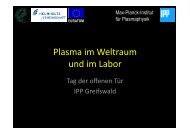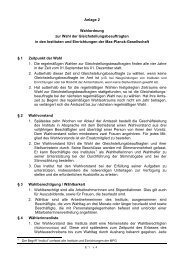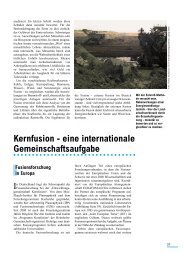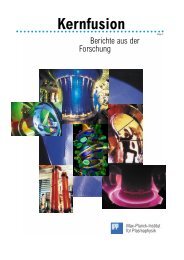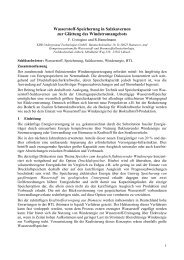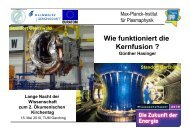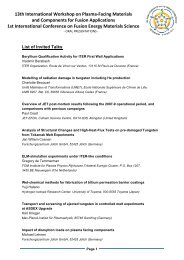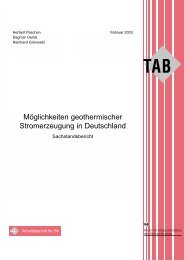IPP Annual Report 2007 - Max-Planck-Institut für Plasmaphysik ...
IPP Annual Report 2007 - Max-Planck-Institut für Plasmaphysik ...
IPP Annual Report 2007 - Max-Planck-Institut für Plasmaphysik ...
Create successful ePaper yourself
Turn your PDF publications into a flip-book with our unique Google optimized e-Paper software.
It measures back-scattered radiation using the other ECRH<br />
antenna and transmission line located in the same port. This<br />
information will be used to infer the 1-D velocity distribution<br />
of the confined fast ions.<br />
The figure 17 above shows the first scattered radiation results,<br />
an important milestone for the diagnostic. The centre most<br />
channels are plotted as a function of time during a plasma<br />
discharge where the receiver antenna is swept twice across<br />
the gyrotron beam. The vertical lines are the time points<br />
where the receiver antenna position is expected to have<br />
maximum overlap. The commissioning is in its final stages<br />
and physics exploitation is expected in the 2008 campaign.<br />
6.7 Radial acceleration of solid hydrogen pellets<br />
Fuelling pellets, injected into the plasma from the magnetic<br />
high field side (HFS), undergo a strong radial acceleration<br />
towards the magnetic low field side (LFS), as observed by a<br />
fast framing camera system. The camera images allow for the<br />
study of the pellet velocity through the whole pellet trajectory<br />
inside the separatrix, revealing a monotonic increase of the<br />
acceleration as the pellet penetrates deeper into the plasma.<br />
The cause of this radial acceleration is thought to originate<br />
from a rocket-effect by the asymmetric ablation of the pellet<br />
surface. The ablation asymmetry is the result of the grad B<br />
drift of the pellet cloud, which is then shifted relative to the<br />
pellet. As the pellet cloud provides shelter for the pellet from<br />
hot plasma electrons, the shift of the cloud towards the LFS<br />
will result in a higher heat flux (i.e. a higher ablation rate) at<br />
the HFS of the pellet, thus there will be a net reaction force on<br />
the pellet caused by the impulse of the leaving particles.<br />
Simulations, based on the simple but yet most powerful pellet<br />
ablation model, the NGS (Neutral Gas Shielding), were performed<br />
to estimate the ablation asymmetry. It was assumed<br />
that the total ablation rate is given by the NGS model, but a<br />
small fraction (ε) of it is asymmetrically produced on the<br />
pellet’s HFS. The corresponding net radial force on the pellet<br />
and hence acceleration is taken into account in the simulation,<br />
resulting in curved pellet trajectories similar to the measurements.<br />
Simulations were performed with pellet and injection<br />
geometry settings identical to those in the measurements.<br />
The asymmetry parameter (ε) was tuned until the simulated<br />
pellet trajectory fitted the measured one separately for each<br />
pellet event, and the corresponding value of ε was considered<br />
as the output of the simulation. Up to now 16 pellet events have<br />
been studied and asymmetry values fell in the range of 3-9 %.<br />
6.8 New stochastic model for the sawtooth crash<br />
The sawtooth oscillation is one of the fundamental instabilities<br />
observed in tokamaks. Still no definitive explanation for<br />
the crash process exists. Incomplete sawtooth reconnection<br />
is often observed. It is associated with an internal m/n=1/1<br />
kink mode which does not vanish after the crash phase (as<br />
would be the case for complete reconnection).<br />
ASDEX Upgrade<br />
16<br />
It was shown that these sawteeth cannot be fully described<br />
by a pure m/n=1/1 mode and that higher harmonics play an<br />
important role during the sawtooth crash phase. We demonstrated<br />
that stochastization appears due to the excitation of<br />
low-order resonances which are present in the corresponding<br />
q-profiles inside the q=1 surface which reflects the key<br />
role of the central q(0)-value. Depending on this value two<br />
completely different situations are possible for one and the<br />
same mode perturbations: (i) the resonant surfaces are present<br />
in the q-profile leading to stochasticity and sawtooth crash<br />
(q(0)=0.7±0.1); (ii) the resonant surfaces are not present,<br />
which means no stochasticity in the system and no crash<br />
event (q(0)=0.9±0.05). Accordingly the central safety factor<br />
value is always less than unity in the case of a non-complete<br />
sawtooth reconnection. Our investigations show that the stochastic<br />
model agrees well with the experimental observations<br />
and can be proposed as a promising candidate for an<br />
explanation of the sawtooth reconnection.<br />
6.9 Extrapolation of AUG H-mode discharges to ITER<br />
Scaling laws predict ITER’s confinement and fusion performance<br />
in H-mode. Besides the well established IPB98(y,2)<br />
law, others have been proposed with a weaker β dependence,<br />
such as Cordey’s (2005) and the GyroBohm scaling laws<br />
(see figure 18).<br />
Q/(Q+5)<br />
1<br />
0.1<br />
0.05<br />
IPB98(y,2) Cordey05<br />
0.1 1<br />
3.23 -1.23 -3.10<br />
35.5 H β q<br />
98 N 95<br />
ES GB<br />
ITER ITER<br />
ITER<br />
0.1 1 0.1 1<br />
1.82 0.18 -2.20<br />
6.07 H Cor β N q 95<br />
2.22 -0.22 -2.71<br />
22.8 H EGB β N q95<br />
Figure 18: 0D figure of merit of Q/(Q+5) assuming a constant Greenwald<br />
fraction for the different scaling laws, versus Q/(Q+5) predicted with the 1D<br />
ASTRA simulations. IPB98(y,2) (red), Cordey 05 (green), GyroBohm (blue)<br />
Theory based dimensionless models also predict the ITER<br />
performance. However, even those based on the same instabilities<br />
yield different core predictions. Moreover they are<br />
strongly sensitive to the pedestal density and temperatures,<br />
which are predicted with large uncertainties. In this work<br />
we extrapolate AUG discharges to ITER, using the information<br />
contained in the scaling laws with additional input<br />
from present experiments, in particular the profile shapes,<br />
the H factors, the thermal normalised pressure β N,th and q 95 .<br />
A profile database of 92 well diagnosed H-mode discharges<br />
has been selected, including only stationary time intervals.<br />
The scaled profiles have then been used for ASTRA simulations<br />
with ITER geometry, in order to predict the P fus and P rad ,<br />
as well as P aux needed to obtain the target β N,th at the given<br />
H-factor. The effect of varying the tungsten concentrations<br />
is also investigated here. Dimensionless figures of merit are




